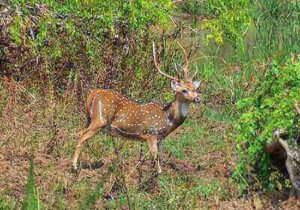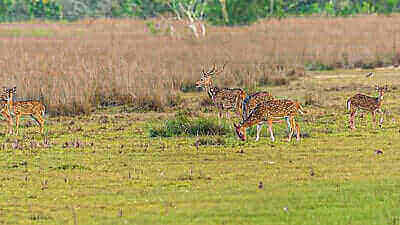Disclosure: We may earn commissions if you purchase products after clicking on a link from our site.
Would you like to hunt exotic animals in Texas? Are you interested in hunting axis deer? Do you want to learn how to hunt axis deer? Axis deer are some of the smartest and wary deer you can come across. They are challenging to hunt with a good sense of smell and good eyesight.
They cover ground quickly and you have to be physically fit if you want to hunt them, especially if you intend to hunt axis deer with a bow. If you want to hunt axis deer in Texas, then we share information to improve your chances of successfully hunting axis deer.

Table of Contents
Axis Deer History
Axis deer, also known as chital or spotted deer, has a rich and fascinating history that spans centuries. Native to the Indian subcontinent, these elegant deer have been revered in Hindu mythology and are considered sacred animals in various cultures.
They were introduced to other parts of the world through deliberate translocations for hunting and aesthetic purposes. Axis deer were first brought to Hawaii in the early 1860s as a gift from King Kamehameha V of Hawaii to rancher Kamehameha, who released them on the island of Molokai.
Later, in the early 1900s, axis deer were introduced to Texas and other parts of the United States for sport hunting and exotic game ranching. Today, axis deer populations thrive in regions with suitable habitats, including parts of the United States, Australia, and Argentina. Their adaptability and resilience have made them a prized species for both hunters and wildlife enthusiasts, contributing to their continued presence and cultural significance around the world.
How To Hunt Axis Deer
1. Scouting Axis Deer
Scouting for axis deer is a crucial aspect of preparing for a successful hunt, requiring hunters to conduct thorough reconnaissance of the deer’s habitat and behavior patterns. Axis deer typically inhabit a variety of habitats, including grasslands, woodlands, and agricultural areas, so scouting often involves exploring diverse landscapes to identify promising hunting grounds.
Hunters can begin by studying maps and aerial imagery to pinpoint areas with suitable habitat features such as water sources, food plots, and bedding areas. Once on-site, hunters can look for signs of axis deer activity such as tracks, droppings, rubs, and bedding sites. Trail cameras can also be strategically placed to monitor deer movements and activity patterns.
Observing deer behavior during different times of the day, such as early morning and late afternoon, can provide valuable insights into their routines and preferred travel routes. Additionally, scouting allows hunters to assess the density and size of the deer population, helping them formulate effective hunting strategies and identify potential ambush sites. By investing time and effort into scouting, hunters can increase their chances of encountering axis deer and enjoy a more productive and rewarding hunting experience.
2. Be Physically Fit
Being physically fit is essential for hunters pursuing axis deer, as it directly impacts their ability to navigate through varied terrain and endure the rigors of the hunt. Axis deer inhabit diverse habitats ranging from open grasslands to dense woodlands, often requiring hunters to traverse rugged terrain, steep slopes, and challenging landscapes.
Maintaining good physical condition improves hunters’ endurance, agility, and overall mobility, enabling them to cover more ground effectively and quietly. Additionally, hunting axis deer often involves extended periods of waiting and stalking, necessitating strength and stamina to remain alert and focused.
By prioritizing physical fitness through activities such as hiking, cardio exercises, and strength training, hunters can enhance their hunting experience, minimize fatigue, and increase their chances of success. Moreover, being in good shape reduces the risk of injury and ensures hunters can fully enjoy the physical and mental demands of the hunt, leading to a more rewarding and fulfilling experience in the great outdoors.
3. Trail Cameras
Using trail cameras when hunting axis deer is an invaluable tool that allows hunters to gather essential information about deer movements, behavior, and patterns without disturbing their natural habitat. These motion-activated cameras can be strategically placed in areas frequented by axis deer, such as feeding areas, trails, or watering holes, to capture images or videos of passing deer.
By reviewing the footage collected by trail cameras, hunters can gain valuable insights into the size, age, and number of deer in the area, as well as their preferred travel routes and activity times. This information enables hunters to make informed decisions about where to set up stands or blinds, plan effective hunting strategies, and increase their chances of encountering and harvesting axis deer.
Additionally, trail cameras can help hunters identify specific individual deer, track their movements over time, and monitor the progression of deer activity throughout the hunting season. Overall, incorporating trail cameras into the hunting process enhances the hunter’s ability to scout and strategize effectively, ultimately leading to a more successful and rewarding hunting experience for axis deer. If you are interested in getting a trail camera, we reviewed the best trail cameras on the market.

4. Hunt Downwind
Understanding wind direction and hunting downwind are critical components of a successful axis deer hunt. Axis deer possess keen senses, particularly their sense of smell, which they rely on to detect potential threats.
As such, hunters must pay close attention to wind direction to ensure they remain undetected while stalking or waiting for deer. Hunting downwind means positioning oneself so that the wind is blowing from the deer’s location toward the hunter, carrying away any human scent and reducing the likelihood of detection.
This strategic positioning allows hunters to approach axis deer more closely without alerting them to their presence, increasing the chances of a successful shot. Additionally, being aware of wind direction helps hunters determine the best locations for stands or blinds, ensuring they can capitalize on favorable wind conditions to remain concealed and effectively intercept passing deer. By prioritizing wind direction and hunting downwind, hunters can minimize the risk of spooking deer and maximize their opportunities for a successful axis deer hunt.
5. Still-Hunt
The Still hunt hunting method is a patient and stealthy approach commonly employed by hunters pursuing axis deer. This method involves moving slowly and quietly through the deer’s habitat, carefully scanning the surroundings for any signs of deer activity.
Axis deer inhabit a variety of habitats, from dense woodlands to open grasslands, and hunters must adapt their movements accordingly, using natural cover such as trees, bushes, and terrain features to conceal their presence. The key to a successful still hunt is to move quietly and deliberately, pausing frequently to observe and listen for any signs of deer movement.
By blending into the environment and remaining patient, hunters can increase their chances of encountering axis deer, which are known for their acute senses and cautious nature. The Still hunt method requires keen observation, sharp shooting skills, and a deep understanding of the deer’s behavior, making it a challenging yet rewarding approach for hunters seeking to harvest axis deer.
6. Spot & Stalk
The spot and stalk hunting method is a popular and effective strategy utilized by hunters pursuing axis deer. This approach involves spotting deer from a distance, often using binoculars or spotting scopes and then carefully stalking within shooting range to make a successful harvest.
Axis deer are known for their keen senses and ability to blend into their surroundings, so hunters must exercise patience, stealth, and strategic positioning to close the distance without alerting the deer. The spot and stalk method is particularly well-suited for hunting axis deer in open terrain, such as grasslands or agricultural fields, where visibility is high and deer movement can be observed from a distance.
By patiently scanning the landscape and methodically closing the gap, hunters can capitalize on favorable shooting opportunities and increase their chances of success. However, this method requires skillful marksmanship and the ability to quickly assess and adapt to changing conditions, making it a challenging yet rewarding approach for hunters seeking to harvest axis deer in their natural habitat.

7. Predator Calls
Using predator calls can be an effective strategy when hunting axis deer, as these calls can pique curiosity or trigger a defensive response from deer. While axis deer are not typically targeted by predators such as coyotes or mountain lions, they may still be intrigued by the sound of distressed prey animals.
Hunters can utilize predator calls that mimic the sounds of wounded or distressed animals, such as rabbits or birds, to attract axis deer within range. By strategically placing themselves downwind of the call and blending into the surroundings, hunters can create a convincing illusion of natural prey distress.
This tactic can be particularly effective during periods of low deer activity or when other hunting methods have proven unsuccessful. However, hunters need to exercise caution and ensure compliance with local hunting regulations when using predator calls, as improper use or overuse of calls may lead to spooking deer or disturbing the natural ecosystem.
Overall, incorporating predator calls into the hunting strategy can add an element of unpredictability and excitement to the hunt, potentially increasing the hunter’s chances of encountering axis deer and achieving a successful harvest.
Use a variety of predator calls and observe which ones work for the axis deer in that area. We reviewed the best predator calls on the market today and you can read it if you are interested in getting a predator call.
8. Bait
Using bait when hunting axis deer can be a strategic method to attract these elusive animals into shooting range. Baiting involves placing food sources, such as corn, grains, or specially formulated deer feed, in designated locations frequented by axis deer.
By enticing deer with a readily available food source, hunters can increase their chances of encountering axis deer and improve their opportunities for a successful harvest. Baiting can be particularly effective during periods of low natural food availability or when deer populations are sparse.
However, hunters must adhere to local hunting regulations regarding baiting, as laws and regulations vary by region. Additionally, hunters should exercise ethical considerations and ensure that baiting practices do not negatively impact the natural behavior of axis deer or disrupt the broader ecosystem. When used responsibly and in conjunction with other hunting strategies, baiting can be a valuable tool for hunters seeking to harvest axis deer in their natural habitat.

Axis Deer Hunting Tips
1. Get in shape if you intend to hunt axis deer with a bow.
2. Axis deer are most active at dusk and dawn.
3. Axis deer are often found in flatter terrain like lowlands.

4. Still-hunt axis deer close to their bedding areas.
5. Spot and stalk axis deer near food sources.
6. Axis deer love the water and spend more time near water than whitetail deer do.

7. Axis deer can rut at any time of the year. However, most of the rut happens from late May to late June.
8. During the rut, you can use the sounds they make to pinpoint their location and hunt them.
9. Use predator calls to hunt axis deer.
10. Axis deer are often seen in a herd as they are very sociable.
11. Axis deer roar often and also when they are alarmed.


The Bottom Line
Hunting axis deer is challenging and exciting. Axis deer is smart and wary. Due to a lot of hunting pressure, axis deer have learned to remain out of sight. When you do see them, they disappear in a few seconds. They are exotic as they are fleeting.
In this article, we discuss how to hunt axis deer. You can also read how to hunt blacktail deer, how to hunt fallow deer, how to hunt sika deer, how to hunt red deer, how to hunt axis deer, and how to hunt blacktail deer.
